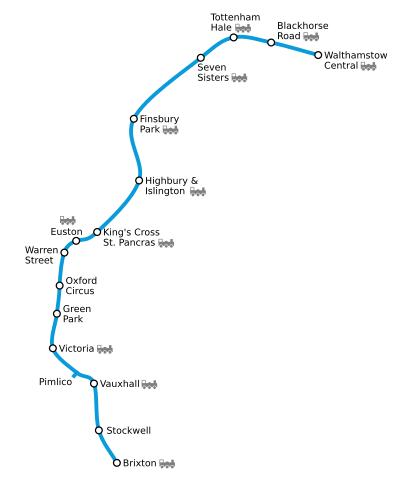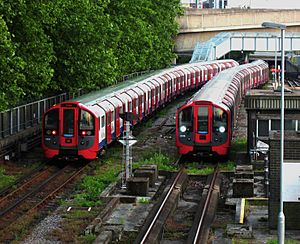Victoria line facts for kids
Quick facts for kids Victoria line |
|
|---|---|
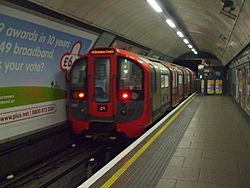
A 2009 stock Victoria line train at Euston
|
|
| Overview | |
| Stations | 16 |
| Colour on map | Light blue |
| Service | |
| Type | Rapid transit |
| System | London Underground |
| Depot(s) | Northumberland Park |
| Rolling stock | 2009 Stock |
| Ridership | 199.988 million (2011/12) passenger journeys |
| History | |
| Opened | 1 September 1968 |
| Technical | |
| Line length | 21 km (13 mi) |
| Character | Deep-level |
| Track gauge | 1,435 mm (4 ft 8 1⁄2 in) |
The Victoria line is a special part of the London Underground train system. It's a deep underground train line. It runs from Brixton in south London all the way to Walthamstow Central in the north-east.
This line started running in 1968. On the Tube map, you can easily spot it because it's shown in a light blue color. It's one of the busiest lines on the London Underground, with about 200 million people using it every year!
The Victoria line is almost completely underground. The only part that comes above ground is the path to the train storage area. This path goes from Seven Sisters to Northumberland Park.
The stations on the Victoria line are built with a special "hump" shape. This means the tracks go slightly uphill as trains arrive at a station. This helps the train slow down naturally. As the train leaves the station, the tracks go downhill. This helps the train speed up. This clever design saves 5% of energy and makes trains run 9% faster! Each new platform built for the Victoria Line is 132.6 meters long.
Contents
History of the Victoria Line
People first thought about building a new tube line from Victoria to Walthamstow in 1948. The main reason was to help with too much traffic in the middle of London. A special plan to build the line was presented to Parliament in 1955. This plan described a line from Victoria to Walthamstow.
Building work on the Walthamstow–Victoria part of the line began in 1962. It finished in 1972 when Pimlico station opened. Before this, a test tunnel was built in 1959. This test tunnel was later used as part of the main line. Prince Charles and Prince Philip even visited the tunnels while they were being built in 1968.
In 1967, Barbara Castle, who was the Minister of Transport, approved building the line's extension to Brixton. Work on this part started in May 1967. Later, in 1968, another Minister, Richard Marsh, approved building a station at Pimlico.
The name "Victoria line" was chosen in 1955. Other ideas were "Walvic line" and "Viking line." During the planning, it was just called Route C. David McKenna suggested the name Victoria line, after Victoria Station.
The Victoria line was designed to make other busy lines, like the Piccadilly line, less crowded. It was also planned to have many places where you could change trains. All stations except Pimlico let you change to at least one other London Underground or National Rail train line.
It was originally planned to extend the line past Walthamstow Central. It would have gone to Wood Street (Walthamstow) and come above ground there. But in 1961, it was decided to stop the line at Walthamstow Central station.
Most Victoria line stations were built so you could easily switch to other lines. Sometimes, the Victoria line platforms were placed next to existing platforms. This made it easy to walk across to another train.
- At Euston, trains going north on the Victoria line and the Northern line (Bank branch) run on platforms right next to each other.
- You can also switch easily at Stockwell (with the Northern line), Oxford Circus (with the Bakerloo line), Highbury & Islington (with First Capital Connect), and Finsbury Park (with the Piccadilly line).
All Victoria line stations were first decorated with light blue tiles. Each station also had special tiled pictures or designs. These designs helped people know which station they were at. For example, Green Park station had green dots that looked like trees.
To make it easier for everyone to use the trains, special ramps called "platform humps" were added. These were put in at all Victoria line stations, except Pimlico, in 2010 and 2011. They help people get onto trains without a big step.
Opening the Victoria Line
The first part of the line opened between Walthamstow Central and Highbury & Islington on September 1, 1968. There was no big party for this opening. The trains just started running normally. Later that year, the section between Highbury & Islington and Warren Street also opened quietly.
The official opening party for the whole line happened at Victoria station on March 7, 1969. Queen Elizabeth II unveiled a special plaque. After a short ceremony, she bought a ticket and rode the train to Green Park. This made her the first monarch to ride the Underground!
Princess Alexandra opened the Brixton extension on July 23, 1971. She rode the train from Brixton to Vauxhall.
Trains and Service
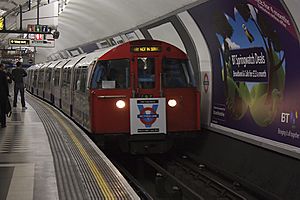
During busy times, like rush hour, trains run every two minutes! Most trains go from Brixton to Seven Sisters. About three out of five trains continue all the way to Walthamstow Central.
When the line first opened, it used 8-car 1967 tube stock trains. Later, some 1972 Mark I tube stock cars were changed to work with the 1967 trains. This meant there were 43 trains in total. The 1967 trains were replaced by newer 2009 tube stock trains between 2009 and 2011.
The new 2009 tube stock trains are wider and a bit longer. This means they can only run on the Victoria line. They are too wide for the tunnels of other deep tube lines.
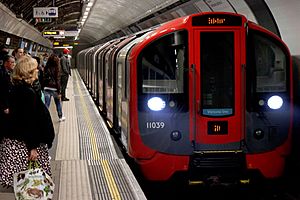
The Victoria line uses an Automatic Train Operation (ATO) system. This means the train operator (driver) just closes the doors and presses "start." If the way is clear, the ATO system drives the train safely to the next station and stops it. This system has been used since the line opened in 1968. This makes the Victoria line the world's first fully automatic railway!
Future Plans
When the Victoria line was built, there wasn't a lot of money. So, some station features were simpler than on older or newer lines. For example, platforms at Walthamstow Central, Blackhorse Road, and Tottenham Hale are narrower. Also, there are concrete staircases where extra escalators could be. This can cause crowding during busy times.
- Extra escalators have been added at Brixton (in 2004) and Vauxhall (in 2006) to help with crowding.
- Sometimes, stations have to close if both escalators are broken.
The older 1967 trains were replaced between 2009 and 2011. The new 2009 tube stock trains were built by Bombardier Transportation. The last 1967 train ran on June 30, 2011. Now, only the 2009 trains are used.
Fans of Tottenham Hotspur F.C. want a new station to be built next to Northumberland Park railway station. This would be near the Victoria line's train storage area. It would make it easier for fans to get to the football stadium. But the land is needed for other railway plans.
When Crossrail 2 is built, it should help make the Victoria line less crowded. It will offer another way to travel across Central London between Victoria and King's Cross St. Pancras.
There have also been ideas to extend the line one stop south from Brixton to Herne Hill. This would help trains turn around more easily. However, this idea would cost too much money for the small help it would give passengers.
Victoria Line Stations
| Station | Image | Opened | Special Design (Motif) |
|---|---|---|---|
| Walthamstow Central |
1 September, 1968 | Motif: A pattern by William Morris. | |
| Blackhorse Road |
1 September, 1968 | Motif: A Black Horse by Hans Unger. | |
| Tottenham Hale |
1 September, 1968 | Motif: A ferry punt by Edward Bawden, showing the old ferry crossing. | |
| Seven Sisters |
 |
1 September, 1968 | Motif: Seven Elm trees on a green background by Hans Unger. |
| Finsbury Park |
1 September, 1968 | Motif: Crossed duelling pistols by Tom Eckersley, because the park was once used for duels. | |
| Highbury & Islington |
1 September, 1968 | Motif: A Manor House on Highbury Hill by Edward Bawden. | |
| King's Cross St. Pancras |
1 December, 1968 | ||
| Euston |
1 December, 1968 | Motif: The Doric Arch at Euston station by Tom Eckersley. | |
| Warren Street | 1 December, 1968 | Motif: A maze or "Warren" by Alan Fletcher. | |
| Oxford Circus |  |
7 March, 1969 | Original motif: An abstract pattern with colors of the Bakerloo, Central, and Victoria lines. |
| Green Park | 7 March, 1969 | Original motif: Green dots representing trees in Green Park by Hans Unger. | |
| Victoria |
7 March, 1969 | Motif: A blue picture of Queen Victoria on a pink background by Edward Bawden. | |
| Pimlico | 14 September, 1972 | ||
| Vauxhall |
23 July, 1971 | Motif: Pictures of the Old Vauxhall Pleasure Gardens by George Smith. | |
| Stockwell | 23 July, 1971 | Motif: A Swan by Abram Games, referring to a nearby pub. | |
| Brixton |
 |
23 July, 1971 | Motif: A "ton of Bricks" by Hans Unger. |
Train Storage and Maintenance Area
Northumberland Park Depot is where Victoria Line trains are stored and fixed. It's the only part of the line that is not in a tunnel. It's located near Northumberland Park railway station in Tottenham.
The Depot is connected to the Victoria Line by a tunnel that branches off north of Seven Sisters. It opened at the same time as the first part of the line in 1968.
There's a local group trying to get a Victoria Line station built at Northumberland Park. This idea is supported by the Haringey Council and the Tottenham Hotspur F.C. football club. They believe new platforms are needed to help more people get to their stadium.
- Brixton
- Stockwell
- Vauxhall
- Pimlico
- Victoria
- Green Park (2nd version)
- Oxford Circus (2nd version)
- Warren Street
- Euston
- King's Cross St. Pancras
- Highbury & Islington
- Finsbury Park
- Seven Sisters
- Tottenham Hale
- Blackhorse Road
- Walthamstow Central
Images for kids
-
A fan shaft and emergency access point at Heron Island, between Blackhorse Road and Tottenham Hale.
See also
 In Spanish: Victoria Line para niños
In Spanish: Victoria Line para niños


